Temporal Evolution, Oscillation and Coherence Characteristics Analysis of Global Solar Radiation Distribution in Major Cities in China’s Solar-Energy-Available Region Based on Continuous Wavelet Transform
Abstract
:Featured Application
Abstract
1. Introduction
2. Study Area and Data
2.1. Study Area
2.2. Data Source
3. Wavelet Analysis
3.1. Continuous Wavelet Transform
3.2. Morlet Wavelet
3.3. Wavelet Coherence Analysis
4. Results and Discussions
4.1. Spatial Variation of Global Solar Radiation
4.2. Periodicity Characteristics of Global Solar Radiation
4.3. Seasonal Variation of Global Solar Radiation
4.4. Wavelet Coherence Analysis of Daily Global Solar Radiation with other Meteorological Factors
4.5. Wavelet Coherence Analysis of Daily Global Solar Radiation with Air Pollutants
5. Conclusions
- (1)
- From the macro perspective, the cities of Harbin, Shenyang, and Beijing, characterized by lower average annual temperatures, exhibit higher annual global solar radiation compared to Wuhan, Shanghai, and Guangzhou, which are geographically closer to the equator. Notably, among these six cities, Wuhan—renowned as one of China’s four furnaces—possesses the lowest annual solar energy reserves. The coherence spectrum analysis of global solar radiation and other meteorological factors in Harbin reveals a strong correlation between global solar radiation and sunshine duration throughout the entire temporal domain. Although the atmospheric temperature is also positively correlated with the global solar radiation, the latter exerts dominant with more intricate influencing factors. This explains the phenomenon of lower global solar radiation in southern China, despite its higher annual average atmospheric temperature.
- (2)
- There exists a positive correlation trend in the annual cycle between global solar radiation and wind speed, with the latter leading by approximately 2 months. This suggests that Harbin’s wind energy reserves are also at a low level during winter when global solar radiation is low. Consequently, combining wind power and solar power generation may not be a feasible energy supply strategy in Harbin.
- (3)
- The correlation spectra between global solar radiation and six common atmospheric pollutants indicate that, with the exception of O3 and global solar radiation, the remaining five atmospheric pollutants exhibit a significant negative correlation with global solar radiation. This observation aligns with the actual conditions in Harbin, where decreased air transmission resulting from increased air pollution caused by heightened fossil fuel consumption during the cold winter has led to a reduction in levels of global solar radiation. By implementing comprehensive planning strategies that prioritize the utilization of natural gas and other clean energy sources instead of coal, oil, and other fossil fuels during periods when solar energy reserves are limited in Harbin’s winters, not only can the overall availability of global solar radiation in the region be enhanced, but also some degree of air quality improvement can be achieved.
- (4)
- Global solar radiation exhibits a negative correlation with atmospheric pressure in the annual cycle, as well as with air humidity and precipitation over shorter time periods. Despite the unavoidable influences of the three meteorological factors on global solar radiation, these relatively stable correlation relationships can be utilized for the long-term and short-term prediction of global solar radiation.
Author Contributions
Funding
Institutional Review Board Statement
Informed Consent Statement
Data Availability Statement
Acknowledgments
Conflicts of Interest
References
- Gilgen, H.; Wild, M.; Ohmura, A. Means and Trends of Shortwave Irradiance at the Surface Estimated from Global Energy Balance Archive Data. J. Clim. 1998, 11, 2042–2061. [Google Scholar] [CrossRef]
- Luo, L.C.; Hamilton, D.; Han, B.P. Estimation of total cloud cover from solar radiation observations at Lake Rotorua, New Zealand. Sol. Energy 2010, 84, 501–506. [Google Scholar] [CrossRef]
- Tang, W.J.; Yang, K.; Qin, J.; Li, X.; Niu, X.L. A 16-year dataset (2000–2015) of high-resolution (3h, 10km) global surface solar radiation. Earta Syst. Sci. Data 2019, 11, 1905–1915. [Google Scholar] [CrossRef]
- Mukrimin, S.G. Solar power and application methods. Renew. Sustain. Energy 2016, 57, 776–785. [Google Scholar] [CrossRef]
- Demirbas, M.F. Electricity production using solar energy. Energy Sources Part A-Recovery Util. Environ. Eff. 2007, 29, 563–569. [Google Scholar] [CrossRef]
- Hepbasli, A.; Alsuhaibani, Z. A key review on present status and future directions of solar energy studies and applications in Saudi Arabia. Renew. Sustain. Energy Rev. 2011, 15, 5021–5050. [Google Scholar] [CrossRef]
- Radzi, A.R.; Nor, A.C.S.; Syahrullail, S. Recent progress on concentrating direct absorption solar collector using nanofluids. J. Therm. Anal. Calorim. 2019, 137, 903–922. [Google Scholar] [CrossRef]
- Li, G.Q.; Li, M.; Taylor, R.; Hao, Y.; Giorgio, B.; Markides, C.N. Solar energy utilisation: Current status and roll-out potential. Appl. Therm. Eng. 2022, 209, 118285. [Google Scholar] [CrossRef]
- Chen, J.L.; Li, G.S. Estimation of monthly average daily solar radiation from measured meteorological data in Yangtze River Basin in China. Int. J. Climatol. 2013, 33, 487–498. [Google Scholar] [CrossRef]
- Mohammadi, K.; Khorasanizadeh, H.; Shamshirband, S.; Tong, C.W. Expression of Concern: Influence of introducing various meteorological parameters to the Angstrom-Prescott model for estimation of global solar radiation. Environ. Earth Sci. 2019, 78, 1. [Google Scholar] [CrossRef]
- Zeki, A.D.; Hussein, A.K.; Sopian, K.; Al-Goul, M.A.; Hussain, A. Effect of dust pollutant type on photovoltaic performance. Renew. Sustain. Energy Rev. 2015, 41, 735–744. [Google Scholar] [CrossRef]
- Coskun, C.; Oktay, Z.; Dincer, I. Estimation of monthly solar radiation distribution for solar energy system analysis. Energy 2011, 36, 1319–1323. [Google Scholar] [CrossRef]
- Matuszko, D. Long-term variability in solar radiation in Krakow based on measurements of sunshine duration. Int. J. Climatol. 2014, 34, 228–234. [Google Scholar] [CrossRef]
- Shen, Y.B.; Wang, B. Effect of surface solar radiation variations on temperature in South-East China during recent 50 years. Chin. J. Geophys. Chin. Ed. 2011, 54, 1457–1465. [Google Scholar] [CrossRef]
- Qi, Y.; Fang, S.B.; Zhou, W.Z. Correlative analysis between the changes of surface solar radiation and its relationship with air pollution, as well as meteorological factor in eastern and western China in recent 50 years. Acta Phys. Sin. 2015, 64, 089201. [Google Scholar] [CrossRef]
- Sweerts, B.; Pfenninger, S.; Yang, S.; Folini, D.; Zwaan, B.V.; Wild, M. Estimation of losses in solar energy production from air pollution in China since 1960 using surface radiation data. Nat. Energy 2019, 4, 657–663. [Google Scholar] [CrossRef]
- Rudy, C.; Francois, G.S.; Huang, Y.X.; Ted, S. Intermittency study of high frequency global solar radiation sequences under a tropical climate. Sol. Energy 2013, 98, 349–365. [Google Scholar] [CrossRef]
- Tsung, E.H.; Bianca, F.; Keh, C.C. Generation of a Typical Meteorological Year for Global Solar Radiation in Taiwan. Energies 2023, 16, 2986. [Google Scholar] [CrossRef]
- Shen, Y.B.; Wang, C.H.; Chen, Y. Variation of surface solar radiation and its influence on temperature change in three provinces of Northeast China. Sci. Geogr. Sin. 2023, 11, 2045–2052. [Google Scholar] [CrossRef]
- Lgnacio, L.C.; Michael, T.C.; Michael, R.; Moetasim, A.; Fulden, B.; Sue, E.H.; Caroline, D.; Bri-Mathias, H.; Carlo, B. Potential impacts of climate change on wind and solar electricity generation in Texas. Clim. Chang. 2020, 163, 745–766. [Google Scholar] [CrossRef]
- Yang, X.; Zhao, C.F.; Zhou, L.J.; Wang, Y.; Liu, X.H. Distinct impact of different types of aerosols on surface solar radiation in China. J. Geophys. Res. Atmos. 2016, 121, 6459–6471. [Google Scholar] [CrossRef]
- Luo, H.; Han, Y.; Lu, C.S.; Yang, J.; Wu, Y.H. Characteristics of surface solar radiation under different air pollution conditions over Nanjing, China: Observation and simulation. Adv. Atmos. Sci. 2019, 36, 1047–1059. [Google Scholar] [CrossRef]
- Zhao, Q.; Yao, W.X.; Zhang, C.X.; Wang, X.; Wang, Y. Study on the influence of fog and haze on solar radiation based on scattering-weakening effect. Renew. Energy 2019, 134, 178–185. [Google Scholar] [CrossRef]
- Zhou, L.H.; Sun, L.; Luo, Y.; Xia, X.; Huang, L.; Liao, Z.Y.; Yan, X.H. Air pollutant concentration trends in China: Correlations between solar radiation, PM2.5 and O3. Air Qual. Atmos. Health 2023, 16, 1721–1735. [Google Scholar] [CrossRef]
- Mohamed, A.E. On the Linear and Nonlinear Interaction between Wind and Wave. J. Coast. Res. 2008, 24, 519–526. [Google Scholar] [CrossRef]
- Sabrine, J.; Manel, E.; Habib, A. Variability of Precipitation in Arid Climates Using the Wavelet Approach: Case Study of Watershed of Gabes in South-East Tunisia. Atmosphere 2017, 8, 178. [Google Scholar] [CrossRef]
- Song, X.S.; Zhang, C.H.; Zhang, J.Y.; Zou, X.J.; Mo, Y.C.; Tian, Y.M. Potential linkages of precipitation extremes in Beijing-Tianjin-Hebei region, China, with large-scale climate patterns using wavelet-based approaches. Theor. Appl. Climatol. 2020, 141, 1251–1269. [Google Scholar] [CrossRef]
- Najaf, I.; Zeeshan, F.; Farrukh, S.; Xin, H.; Umer, S.; Ma, L. The nexus between COVID-19, temperature and exchange rate in Wuhan city: New findings from partial and multiple wavelet coherence. Sci. Total Environ. 2020, 729, 138916. [Google Scholar] [CrossRef]
- Sun, Q.Q.; Zhang, P.; Wei, H.; Liu, A.X.; You, S.C.; Sun, D.F. Improved mapping and understanding of desert vegetation-habitat complexes from intraannual series of spectral endmember spare using cross-wavelet transform and logistic regression. Remote Sens. Environ. 2020, 236, 111516. [Google Scholar] [CrossRef]
- Sreedevi, V.; Vahid, N. Multiscale coherence analysis of reference evapotranspiration of north-western Iran using wavelet transform. J. Water Clim. Chang. 2022, 13, 505–521. [Google Scholar] [CrossRef]
- Elena, E.B.; Shapovalov, S.N.; Kostuchenko, I.G. Solar Spectral Irradiance and Total Solar Irradiance at a Solar Minimum. Geomagn. Aeron. 2014, 54, 926–932. [Google Scholar] [CrossRef]
- Sajid, H.; Ali, A.A. A new approach for model validation in solar radiation using wavelet, phase and frequency coherence analysis. Appl. Energy 2016, 164, 639–649. [Google Scholar] [CrossRef]
- Chang, T.P.; Liu, F.J.; Ko, H.H.; Huang, M.C. Oscillation characteristic study of wind speed, global solar radiation and air temperature using wavelet analysis. Appl. Energy 2017, 190, 650–657. [Google Scholar] [CrossRef]
- Chen, X.B.; Yin, L.R.; Fan, Y.L.; Song, L.H.; Ji, T.T.; Liu, Y.; Tian, J.W.; Zheng, W.F. Temporal evolution characteristics of PM2.5 concentration based on continuous wavelet transform. Sci. Total Environ. 2020, 699, 134244. [Google Scholar] [CrossRef] [PubMed]
- Gao, M.L.; Gong, H.L.; Chen, B.B.; Li, X.J.; Zhou, C.F.; Shi, M.; Si, Y.; Chen, Z.; Duan, G.Y. Regional land subsidence analysis in eastern Beijing plain by InSAR time series and wavelet transforms. Remote Sens. 2018, 10, 365. [Google Scholar] [CrossRef]
- Wang, J.J.; Lu, X.M.; Yan, Y.T.; Zhou, L.G.; Ma, W.C. Spatiotemporal characteristics of PM2.5 concentration in the Yangtze River Delta urban agglomeration, China on the application of big data and wavelet analysis. Sci. Total Environ. 2020, 724, 138134. [Google Scholar] [CrossRef]
- Li, K.; He, F.N. Analysis on Mainland China’s Solar Energy Distribution and Potential to Utilize Solar Energy as an Alternative Energy Source. Prog. Geogr. 2010, 29, 1049–1054. [Google Scholar] [CrossRef]
- GB/T 31155-2014; Classification of Solar Energy Resources—Global Radiation. Standards Press of China: Beijing, China, 2014. Available online: https://openstd.samr.gov.cn/bzgk/gb/newGbInfo?hcno=8327621DA9761762427A760CC5F3FE73 (accessed on 6 June 2023).
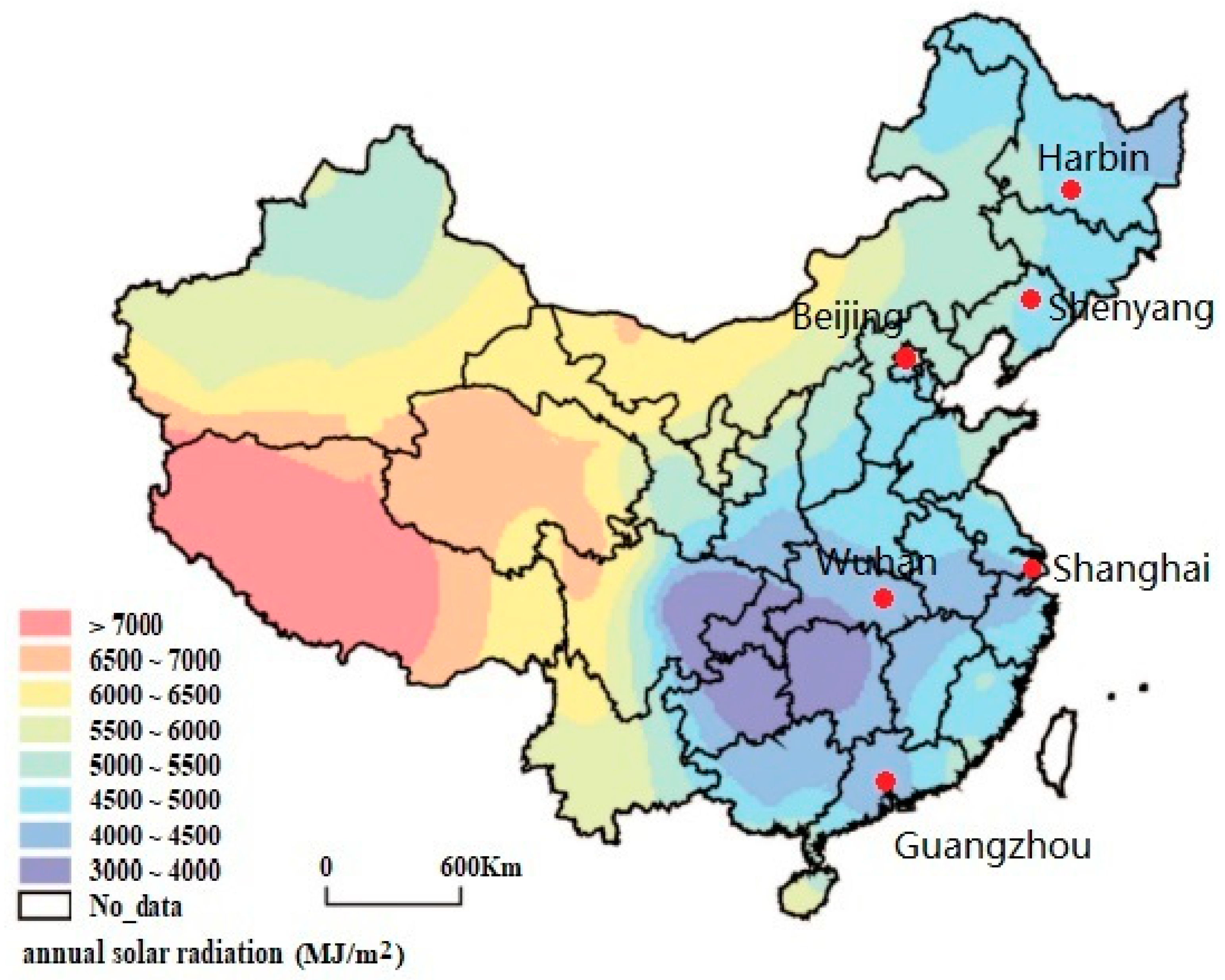


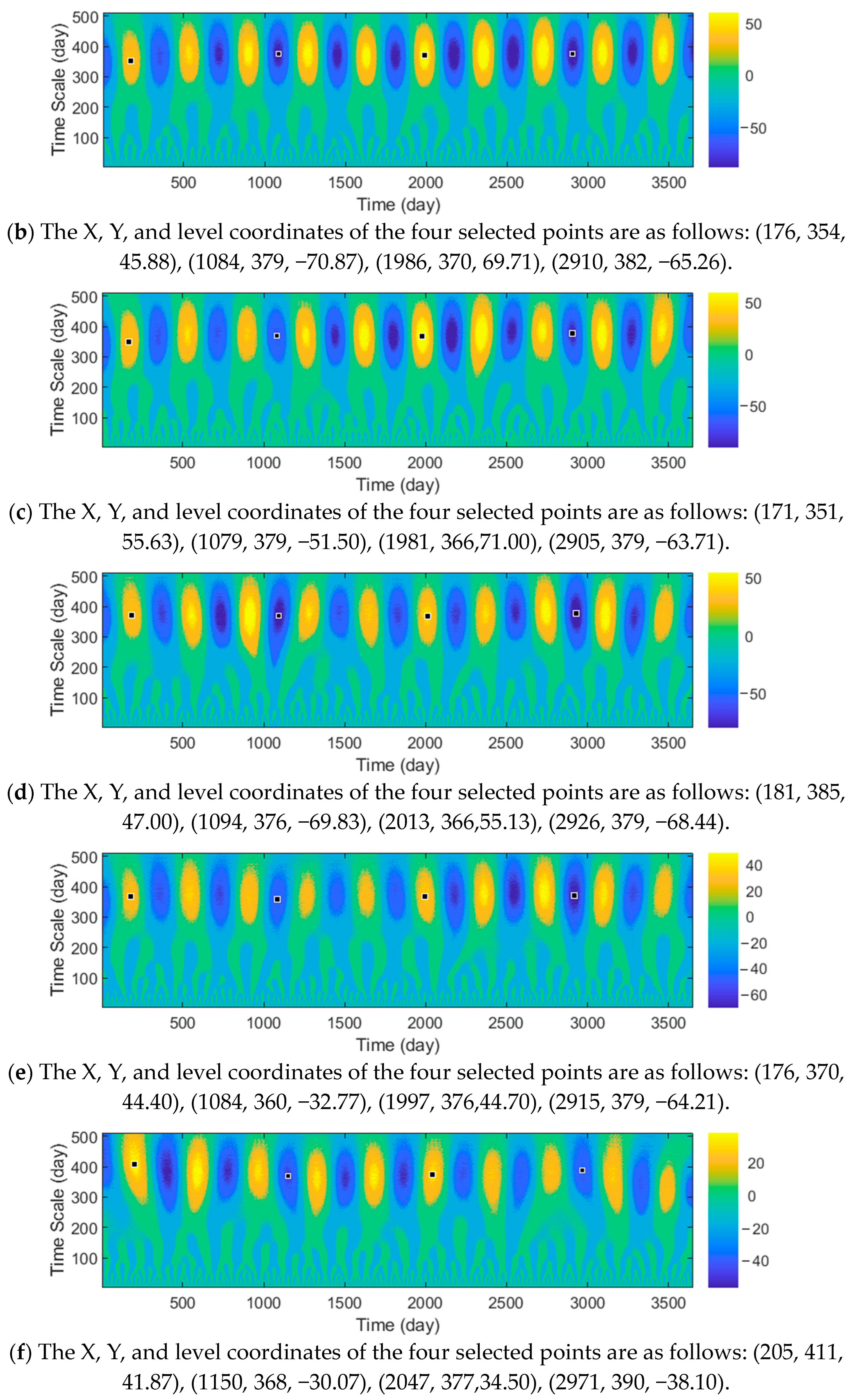
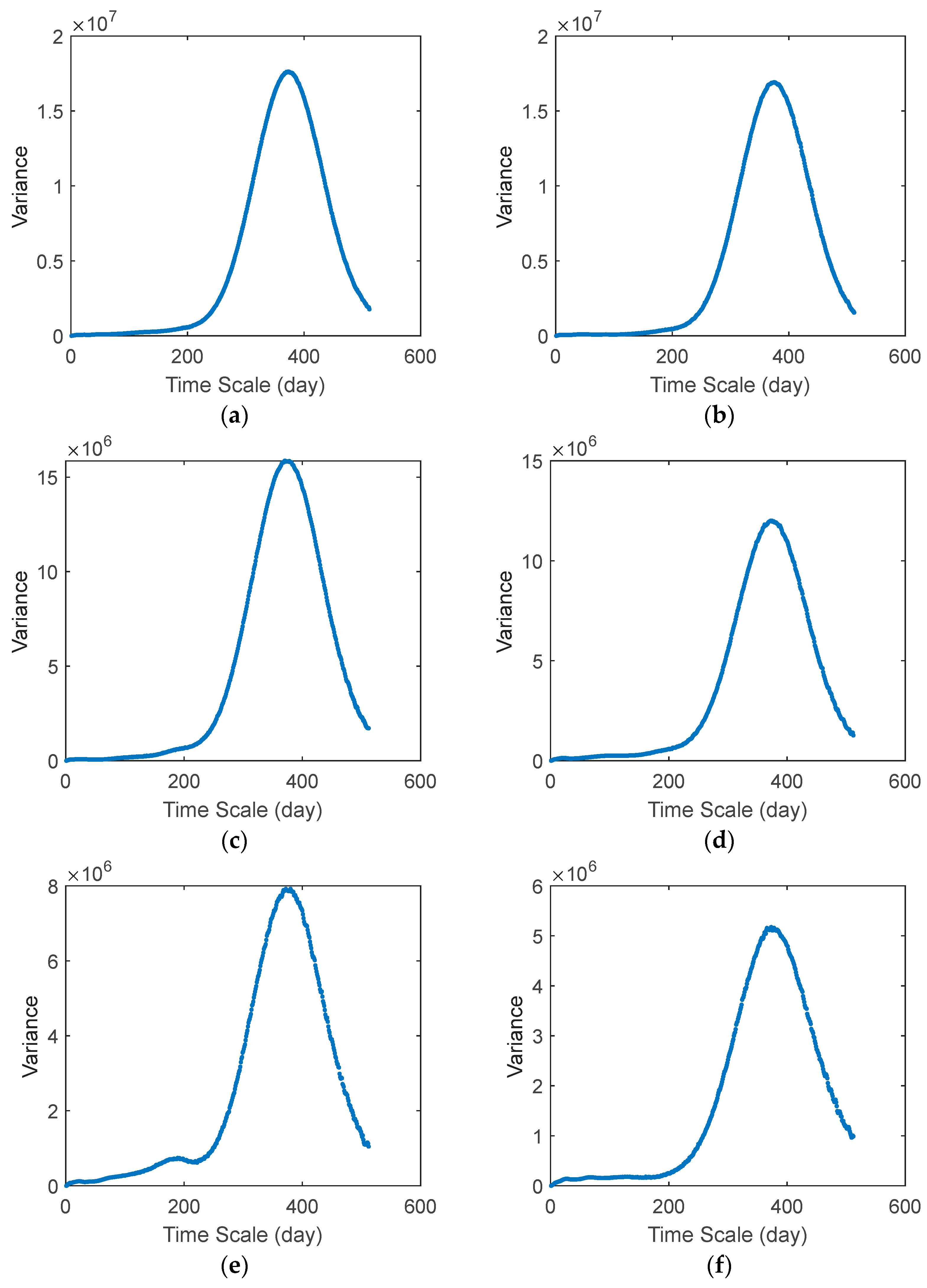
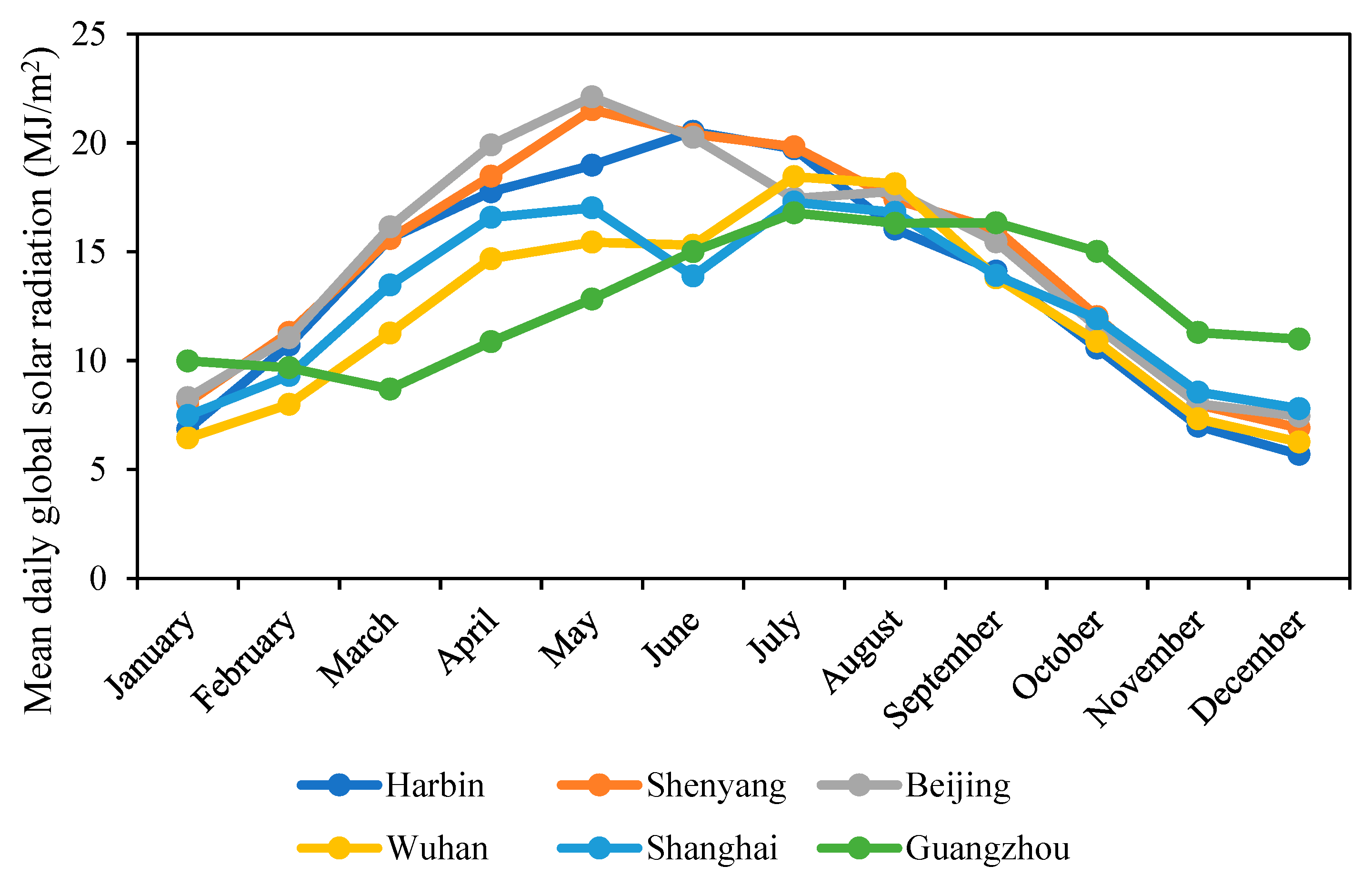
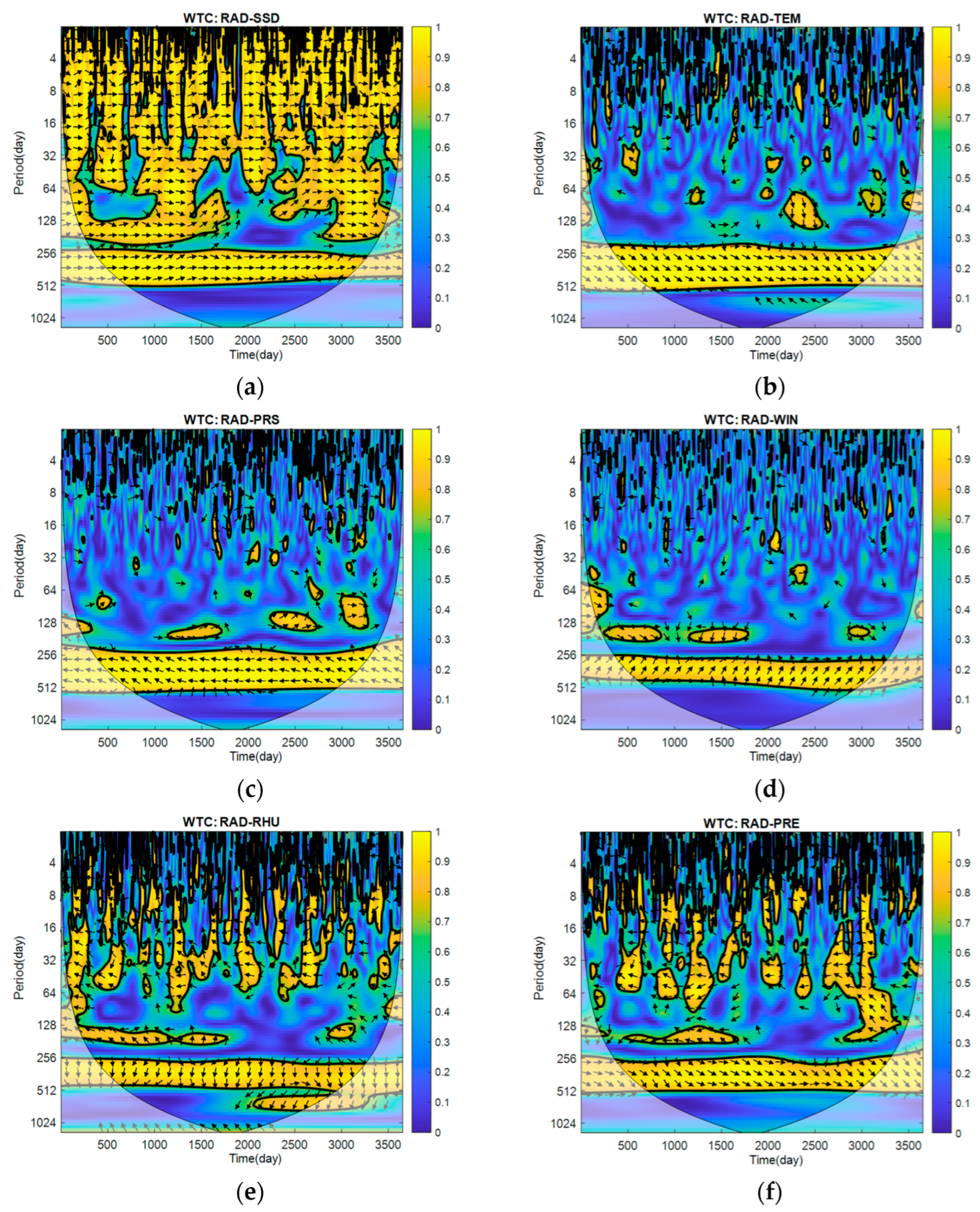
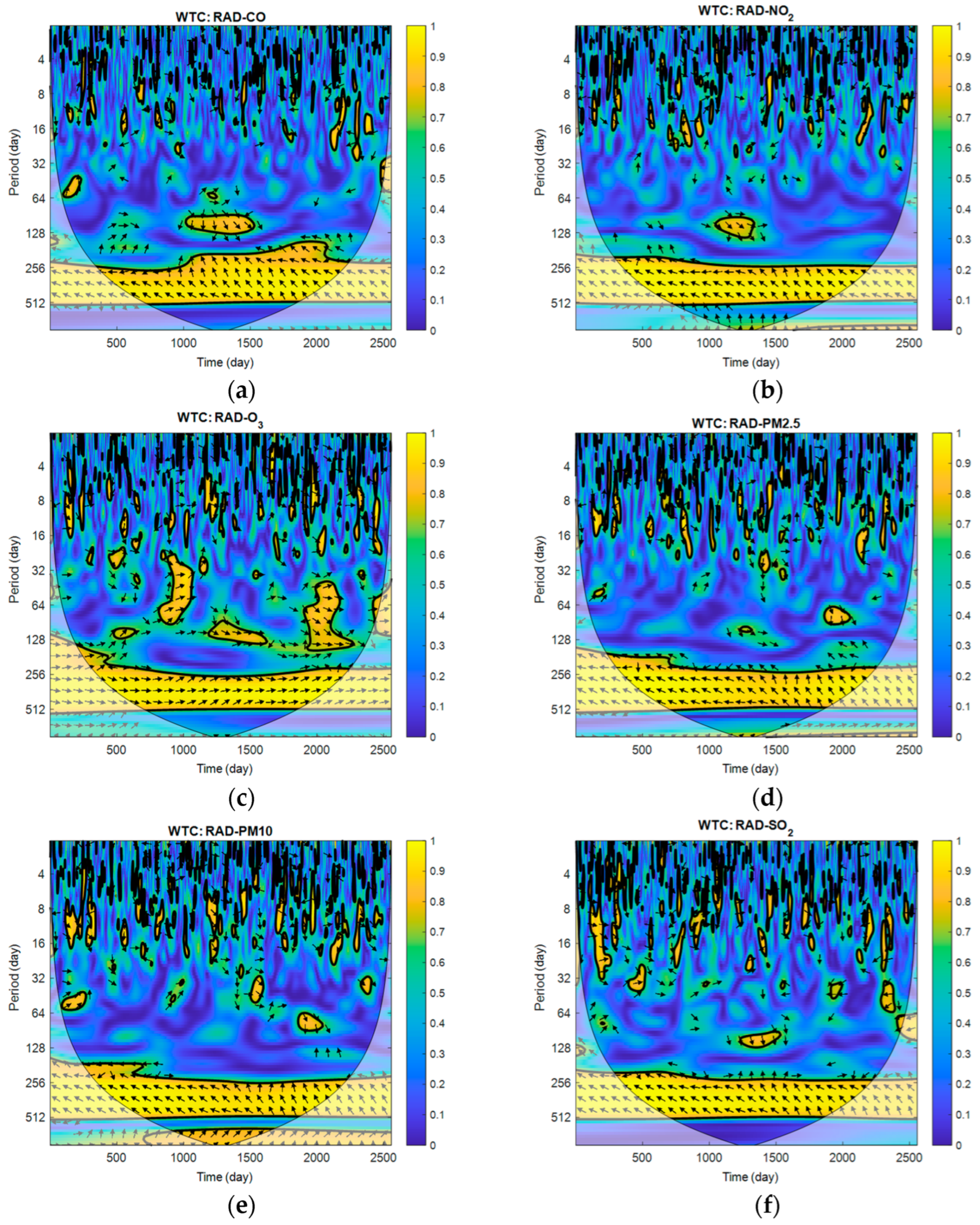
| Grade | Threshold (MJ/m2) | Rank Symbol |
|---|---|---|
| Rich area | A | |
| Relatively rich area | B | |
| Available area | C | |
| Poor area | D |
| Grade | Threshold (MJ/m2) | Grade |
|---|---|---|
| Rich | 1 | |
| Relatively rich | 2 | |
| Available | 3 | |
| Poor | 4 |
Disclaimer/Publisher’s Note: The statements, opinions and data contained in all publications are solely those of the individual author(s) and contributor(s) and not of MDPI and/or the editor(s). MDPI and/or the editor(s) disclaim responsibility for any injury to people or property resulting from any ideas, methods, instructions or products referred to in the content. |
© 2024 by the authors. Licensee MDPI, Basel, Switzerland. This article is an open access article distributed under the terms and conditions of the Creative Commons Attribution (CC BY) license (https://creativecommons.org/licenses/by/4.0/).
Share and Cite
Xue, H.; Li, G.; Qi, D.; Ni, H. Temporal Evolution, Oscillation and Coherence Characteristics Analysis of Global Solar Radiation Distribution in Major Cities in China’s Solar-Energy-Available Region Based on Continuous Wavelet Transform. Appl. Sci. 2024, 14, 4794. https://doi.org/10.3390/app14114794
Xue H, Li G, Qi D, Ni H. Temporal Evolution, Oscillation and Coherence Characteristics Analysis of Global Solar Radiation Distribution in Major Cities in China’s Solar-Energy-Available Region Based on Continuous Wavelet Transform. Applied Sciences. 2024; 14(11):4794. https://doi.org/10.3390/app14114794
Chicago/Turabian StyleXue, Haowen, Guoxin Li, Dawei Qi, and Haiming Ni. 2024. "Temporal Evolution, Oscillation and Coherence Characteristics Analysis of Global Solar Radiation Distribution in Major Cities in China’s Solar-Energy-Available Region Based on Continuous Wavelet Transform" Applied Sciences 14, no. 11: 4794. https://doi.org/10.3390/app14114794






